The 11 Best Fans of 2024, Tested and Reviewed
Dotdash Meredith and Yahoo Inc. may earn commission or revenue on some items through the links below.
Our top pick is the Pelonis Standing Fan
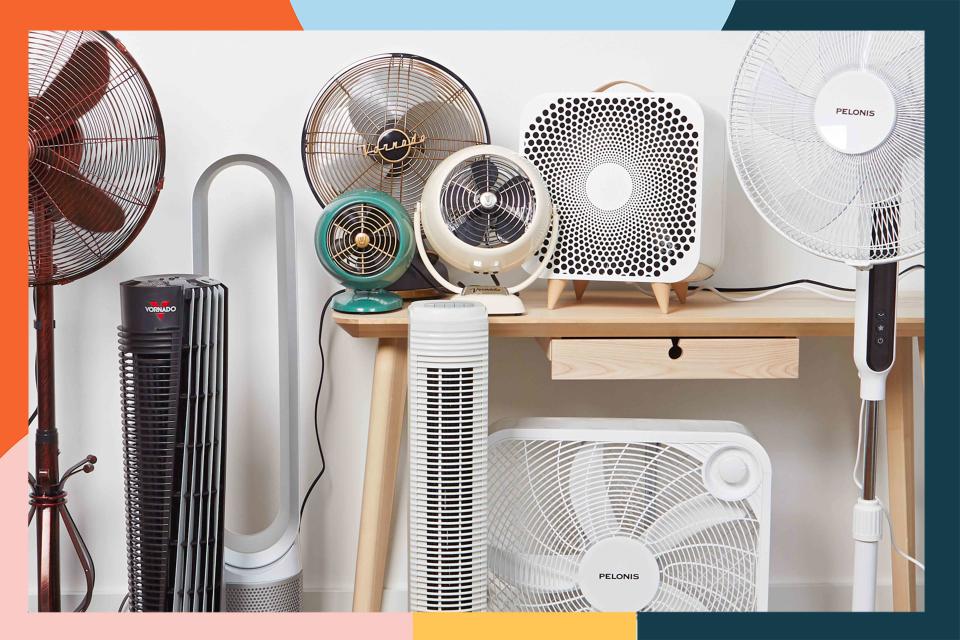
People / Rachel Marek
When the hottest days of summer make you feel like you’re melting into the couch, a powerful fan can provide a much-needed reprieve from the heat. Whether used on their own or alongside an air conditioner, the best fans can create a lovely breeze to help cool down both you and your living space.
“Fans work by moving air in a space and directing it towards you,” explains Theo Jones, Design Engineer in Environmental Care at Dyson. “The cool feeling you get is from the air passing across your skin and wicking away the tiny amounts of moisture on your skin surface.”
If you’re shopping for a fan to help cool down your home, there are a few important decisions you’ll have to make. First, you’ll need to choose the style of fan that will work best in your home — there are standing fans, box fans, window fans, and more to choose from — and you’ll also want to consider its power and speed settings. Other features you may want to look for as you shop include oscillation, built-in timers, and even air purification, which can help remove allergens from your home. To help narrow down your options, we tested more than 30 popular fans in a variety of styles, evaluating them on their design, effectiveness, portability, and more.
These are the best fans PEOPLE tested.
Best Overall: Pelonis 16-Inch Pedestal Fan

Pros
Even at its highest speed, the fan is quiet enough that it won’t disturb you.
You can feel the fan’s breeze from 20 feet away on its highest setting.
It’s quick and easy to adjust the shaft of the fan to your preferred height.
Cons
This fan is heavier than other options, which makes it a bit harder to move around your home.
For a powerful fan that’s well-made and versatile, the Pelonis Standing Fan is our top pick. This pedestal-style fan offers 12 different speeds — the most out of all our winners — and it has a variety of useful settings to tailor its performance to your needs. It offers a 12-hour timer, 85-degree oscillation angle, and 24-degree head tilt, and it’s even height-adjustable, allowing you to select a height between 3.5 and 4 feet.
This fan blew us away during testing — pun intended! The unit feels extremely durable and well-made, and our tester noted that the heavy base was sturdy enough that she didn’t worry about her dog knocking it over. On its lower speeds, this fan is virtually silent, making it ideal for use in the bedroom, and on its highest setting, we could still feel its breeze standing 20 feet away.
Our tester even noted that the fan helped to improve her sleep: “Having this fan on at night seems to have improved my sleep,” she wrote. “The room stays at the perfect temp, not too hot and not too cold, and there's virtually no noise, which means I don't have to turn my TV volume up.”
Overall, the Pelonis Standing Fan is a versatile option that’s well-priced, and it would work well in a variety of applications. The only (small) negative that we could find is that it’s heavier than other fans we tested, making it a bit more cumbersome to move around your home.
Dimensions: 15.75 x 15.75 x 51.18 inches | Weight: 12.35 pounds | Speeds: 12 | Timer: Yes | Remote: Yes | Oscillation: Yes
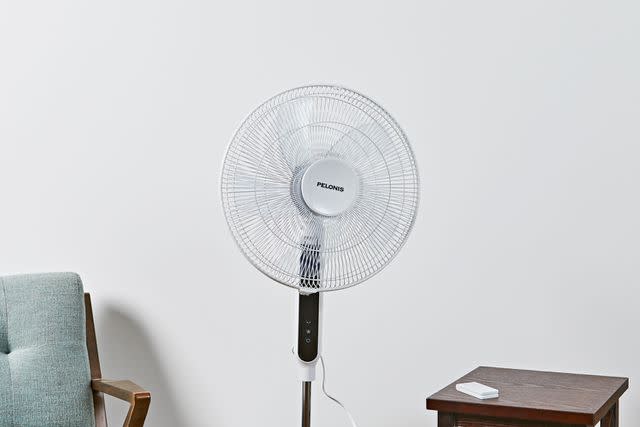
People / Rachel Marek
Best Budget: Honeywell TurboForce Air Circulator Fan

Pros
This fan creates a powerful enough breeze to circulate air in smaller spaces.
The fan is quiet enough to have a conversation over it, even when you’re sitting nearby.
The lightweight design can be carried with just one hand thanks to its built-in handle.
Cons
This fan doesn’t offer any type of oscillation, so it’s fixed in one position during use.
The Honeywell TurboForce Fan still packs a powerful punch, despite its small size and budget-friendly price. This compact fan weighs less than 3 pounds, making it easy to move around your home, and it offers three fan speeds, as well as several head tilt angles. You can even mount it on the wall, if desired, but it doesn’t have a timer, oscillation, or a remote control.
During testing, we were impressed with the breeze created by this fan on its high setting — we were able to feel the air movement from 20 feet away! It’s fairly noisy on its highest setting, but the lower speeds are quiet enough that it won’t disturb your everyday tasks, whether you’re watching TV or taking a Zoom call. Plus, despite being made from plastic, the construction of this fan is still sturdy and durable, and it held up perfectly over our six-month testing period.
Dimensions: 6.3 x 10.9 x 10.9 inches | Weight: 2.6 pounds | Speeds: 3 | Timer: No | Remote: No | Oscillation: No
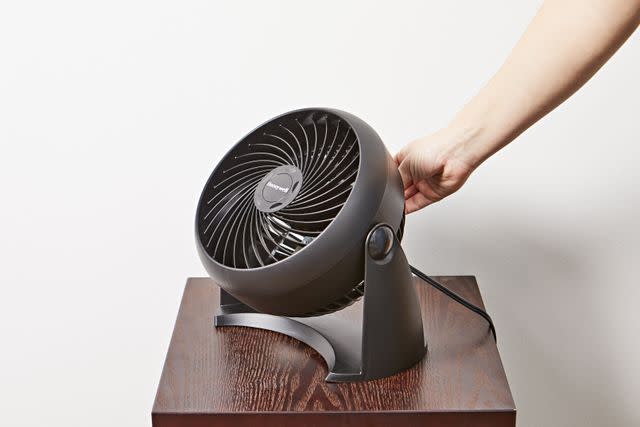
People / Rachel Marek
Best Splurge: Dyson Pure Cool Purifying Fan

Pros
This fan’s unique design doesn’t have any blades, making it safer for use around children or pets.
On its highest setting, the fan creates a breeze that can be felt up to 20 feet away.
This fan has a much more stylish, modern design than other tower fans, making it an attractive addition to your living space.
Cons
Despite its high price point, this fan is mostly made of lightweight plastic.
The fan doesn’t create a noticeable breeze when it’s on the lowest settings.
If you don’t mind splurging on a fan for your home, the Dyson Pure Cool is definitely one of the most high-tech and stylish options out there. This pricey tower fan has a sleek modern design, and as an added bonus, it doesn’t have any fan blades, making it a bit safer for your kids and pets. It offers 10 fan speeds, as well as features like a magnetic remote control, 70-degree oscillation, and a built-in timer. It also does double duty as an air purifier, using a HEPA filter to remove microscopic particles from the air in your home.
During testing, the design of the Dyson Pure Cool made it stand out: “Not only is the shape really sleek and unimposing, but the lack of blades makes it look particularly streamlined,” said our tester. We found that it’s extremely quiet on lower settings, but if you want a strong breeze, you can dial up the power and push air all around your space. Besides its high price point, the only other downside to this fan is that most of its components are made from plastic — we think they could have been a bit higher quality considering how much you’re paying.
Dimensions: 7.5 x 7.5 x 40 inches | Weight: 8.4 pounds | Speeds: 10 | Timer: Yes | Remote: Yes | Oscillation: Yes
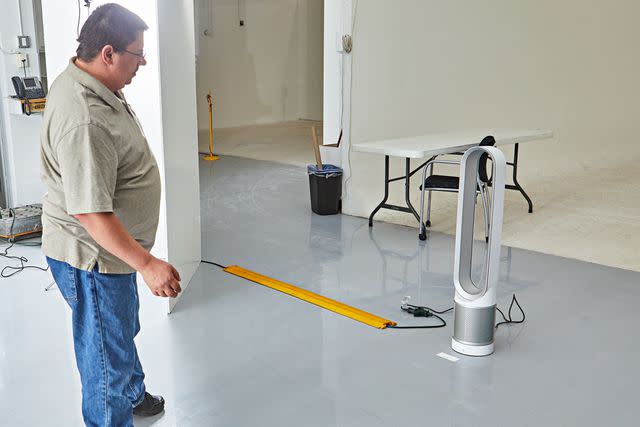
People / Rachel Marek
Best Quiet: Honeywell QuietSet Whole Room Tower Fan

Pros
Even at its highest speed, the fan is quiet enough that it won’t bother you during the day or while you’re sleeping.
The fan is able to quickly cool down small living spaces thanks to its powerful breeze and oscillation.
The control panel can be dimmed if the light bothers you at night.
Cons
The power cord must be carefully aligned within the base, otherwise the fan is very wobbly.
The HoneyWell QuietSet Tower Fan is a top pick for a bedroom, nursery, or any other room where quiet operation is important. We were impressed at how little noise this fan makes, even on the highest of its five speeds — it’s audible but not loud enough that it will disturb your sleep or other activities.
This tower fan is 40 inches tall, and it offers an 8-hour timer, oscillation, and remote control that can be docked on the backside of the fan. It even offers a dimmable control panel so the light doesn’t disturb you at night. The one negative about this fan is that the base is poorly designed: It’s fairly light, making the fan top-heavy, and if you pick the fan up and move it, the power cord often becomes dislodged from its notch, making the fan wobble when you put it back down.
Dimensions: 10 x 10 x 40 inches | Weight: 8 pounds | Speeds: 5 | Timer: Yes | Remote: Yes | Oscillation: Yes
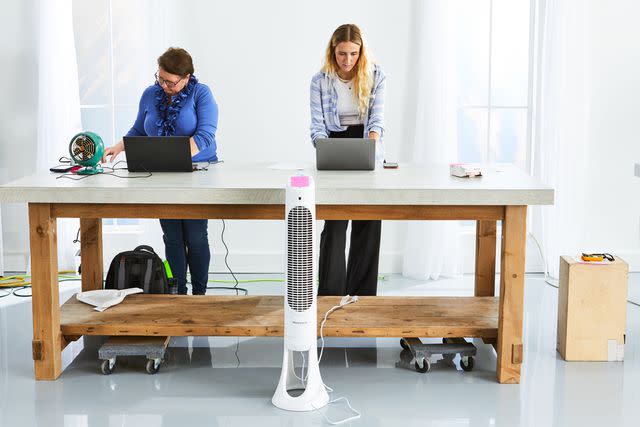
People / Rachel Marek
Best Box Fan: Pelonis 3-Speed Box Fan

Pros
This fan is more powerful than most and is effective at cooling down larger spaces—you can still feel a noticeable breeze from it at 20 feet away.
Thanks to its two handles and light weight, the fan is very easy to move around your home.
Cons
On its highest setting, the fan is quite noisy and will disrupt conversations.
The controls are somewhat confusing — when you turn it on via the dial, the fan starts on the highest setting, not the lowest.
The Pelonis Box Fan has a basic design that’s straightforward to operate, and it’s a great option if you want to create a strong breeze in a medium to large room. As its name suggests, this fan has a square form — ideal for putting in a window or even on the floor — and it has three speed settings that you control via a knob in the corner of the fan. However, we didn’t love the way the knob was programmed. “To turn the fan on, you turn the knob, but rather than starting on the lowest setting, it starts on the highest,” said our tester. “I find it weird that you have to go through the highest settings first to get to the lowest.”
In our testing, this fan provided a powerful breeze that can be felt from across a large space, but it is definitely noisy, even on its lowest setting. The construction is sturdy yet lightweight, and we thought the fan was easy to carry around with one hand thanks to its built-in handles. Overall, the design is simple. There’s no remote or timer, but it’s a solid no-frills choice for cooling down your home.
Dimensions: 5.6 x 20.6 x 21.3 inches | Weight: 7.83 pounds | Speeds: 3 | Timer: No | Remote: No | Oscillation: No
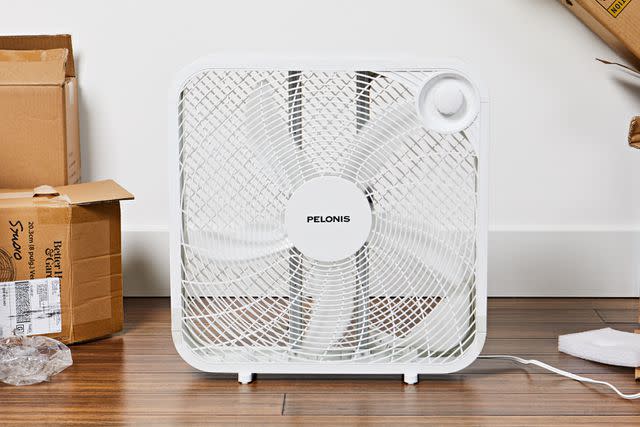
People / Rachel Marek
Best Tower Fan: Better Homes & Gardens 40-Inch 3-Speed Tower Fan

Pros
This fan has a more sleek, contemporary design than other tower fans.
The unique internal oscillation keeps the fan stable while still pushing air throughout the room.
The lightweight design is easy to move with just one hand, as there’s a handle built into the back.
Cons
The vertical vents in the tower make it difficult to reach inside to remove dust buildup.
The base of this fan is slightly wobbly.
Tower fans are popular because they have a compact footprint that doesn’t take up much space in your home, and in this category, we recommend the Better Homes & Gardens Tower Fan. It has a sleek design that’s available in either black or white, and it offers three fan speeds, as well as three wind speeds (which uses varied airflow to recreate the feeling of a natural breeze), for a total of six different settings. The tower fan comes with a magnetic remote control that can be stored on top of the fan, and it has a 7.5-hour programmable timer, too.
This tower fan produced powerful airflow during testing: “The airflow is strong and keeps the room much cooler, eliminating the need to keep the air condition running,” said our tester. We also found that it’s quiet enough to run in a bedroom, especially on its lower setting. Another feature that made this fan stand out is its internal oscillation — the fan louvers rotate within the housing, keeping the unit more stable. However, we did find that the fan grate is quite tricky to clean because the slats are so close together.
Dimensions: 12 x 12 x 41.5 inches | Weight: Not listed | Speeds: 3 | Timer: Yes | Remote: Yes | Oscillation: Yes
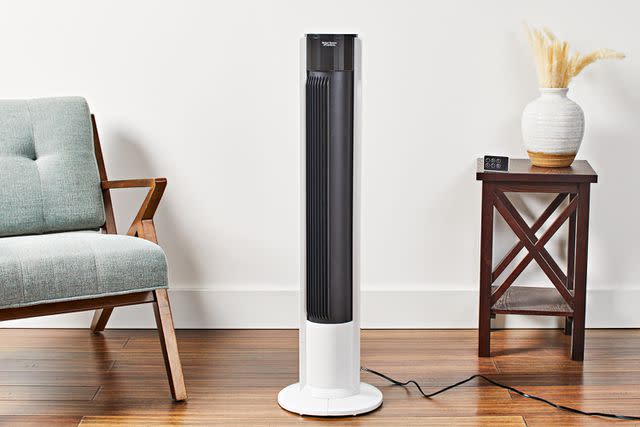
People / Rachel Marek
Best Window Fan: Genesis A1 Window Fan

Pros
Because it has two fan heads, it creates more efficient air flow and can even push air out of your home.
Despite its small form, the fan is extremely powerful on its highest setting and pushes air across a wide area.
Cons
The fan’s “temperature controls” are confusing and don’t seem to offer much functionality.
The feet are hard to take off, making it tricky to switch between freestanding and window operation.
The Genesis Window Fan can be installed directly into a window in your home thanks to its expanding side panels. This unit actually has two 9-inch fan heads, and you turn on each one independently or use them both at the same time. There are three speed settings, but the fan also has five “temperature” settings, which we thought were a bit misleading since it’s not actually cooling the air in your home.
Still, we were impressed by the performance of this fan — it does a superior job circulating air around a room, potentially because of its dual fan heads. We also loved that you’re able to reverse the direction of each fan, if desired, which is handy for pushing hot air out of your home. While the fan does come with detachable feet that allow it to be used freestanding, the feet were challenging to remove and attach, making for a frustrating transition.
Dimensions: 24 x 12 x 4 inches | Weight: 8.4 pounds | Speeds: 3 | Timer: No | Remote: No | Oscillation: No
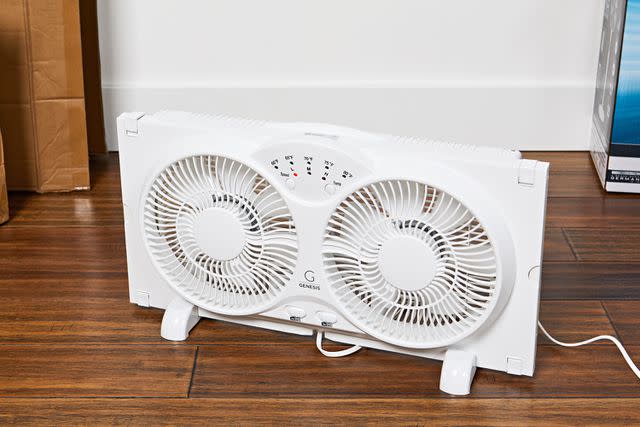
People / Rachel Marek
Best Desk Fan: Vornado 660 Large Air Circulator

Pros
While small, this fan is powerful enough to circulate air around a large room.
You can feel the fan’s breeze from 20 feet away on its highest setting.
Cons
The fan is bulkier than you might expect for a desk fan, and it doesn’t have a handle for moving it around.
If you’re looking for a fan that’s small but powerful, the Vornado 660 is one of the best options out there. Designed as an air circulator, this unit excels at moving air around the entire room, yet it’s compact enough to place on your desk or other raised surface. It has four speed settings with push-button controls on the back of the fan, and while it doesn’t oscillate, you can tilt the fan head to the right angle for your needs.
During testing, the Vornado was able to effectively circulate air around a large, lofty room, and our reviewer described it as “small and mighty.” You can easily feel its breeze from 20 feet away, but the design is fairly bulky for a desktop unit. Additionally, it’s quite expensive considering its size.
Dimensions: 13.5 x 11.8 x 15 inches | Weight: 7.3 pounds | Speeds: 4 | Timer: No | Remote: No | Oscillation: No
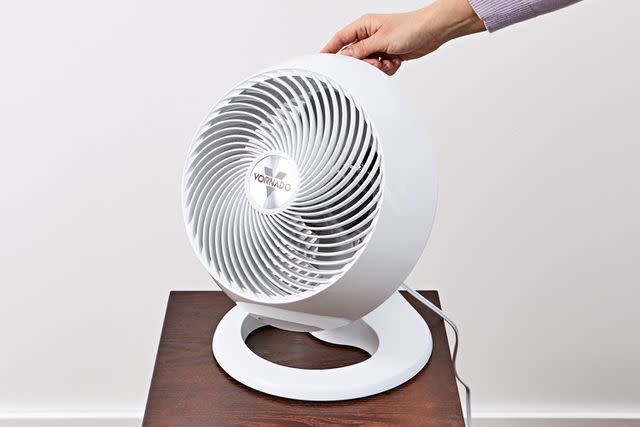
People / Rachel Marek
Best for Small Spaces: Lasko Wind Curve Tower Fan

Pros
This fan creates a strong breeze that can be felt from around 10 feet away.
On its lower settings, the fan is so quiet that you can’t tell it's on.
Cons
The design, which has a faux wood finish, might not appeal to everyone.
The fan is heavy and cumbersome to move around, despite having a built-in handle.
The Lasko Tower Fan is ideal for small spaces — not only does it produce a powerful breeze that will cool down the room, but it also takes up minimal space thanks to its tall, skinny form. This fan offers three speeds, oscillation, and a 7.5-hour timer, and you can adjust its settings from the digital control panel or the included remote. However, it is on the heavier side, weighing 13.5 pounds, and we noticed it’s a bit bulky and awkward to move around.
The tower fan has a woodgrain-inspired front panel, which may not be everyone’s cup of tea, but it’s definitely up to snuff in terms of its performance. “It is a really powerful fan, that's easy to switch between modes, and is very quiet,” our tester noted. “In fact, sometimes I forget to turn it off because it's not loud at all.” If you want to use this fan in your bedroom, it also has a special nighttime mode that automatically decreases the fan speed and dims the display so it won’t disturb you when the room is dark.
Dimensions: 13 x 13 x 42.5 inches | Weight: 13.5 pounds | Speeds: 3 | Timer: Yes | Remote: Yes | Oscillation: Yes
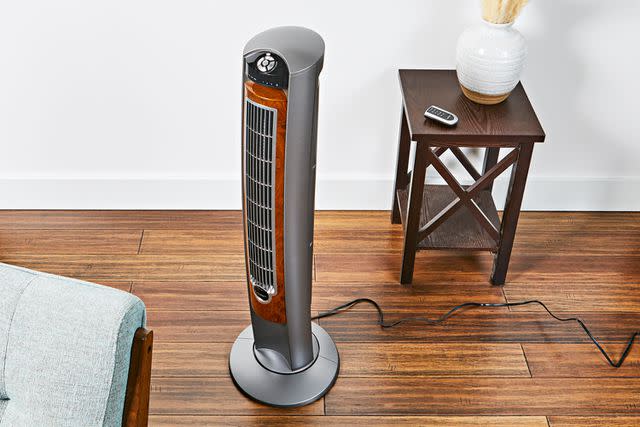
People / Rachel Marek
Best Portable: Crane Circulating Desk Fan

Pros
The fan can be set to three different positions, allowing you to angle its airflow as needed.
While it is small, the fan still creates a breeze that you can feel from up to 20 feet away.
The fan folds down into a compact form when not in use, making it easy to store in smaller homes.
Cons
Considering its small size and basic operation, the fan is a bit expensive.
If you’re planning to move your fan around often, the Crane Desk Fan scored top marks in terms of its portability. We found that it was lightweight and easy to carry, and its design lends itself well to easy storage: “It has a unique design that's sleek yet functional,” our tester said. “The top part of the fan folds down when not in use, so it'd be easy to stack in storage.”
This desk fan has three speeds, and its head can be tilted 90 degrees vertically. It comes with a remote control, as well as an oscillation setting and built-in timer. Essentially, it offers all the same features as a full-size fan. Plus, we were able to feel its breeze from up to 20 feet away, so it’s definitely powerful enough to cool down an office space, RV, or other space.
Dimensions: 9.75 x 9.75 x 7.75 inches | Weight: 6.05 pounds | Speeds: 3 | Timer: Yes | Remote: Yes | Oscillation: Yes
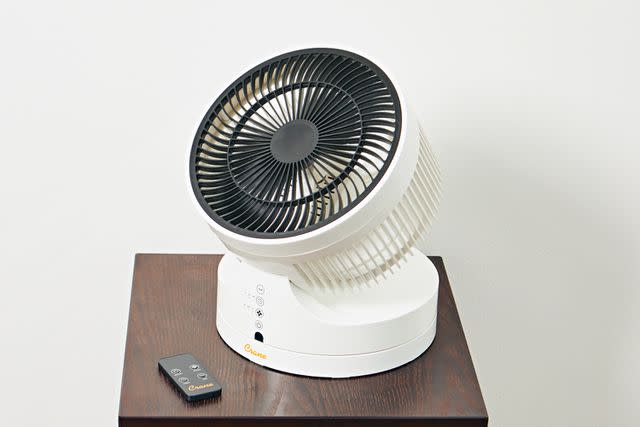
People / Rachel Marek
Best Personal Fan: JisuLife Handheld Mini Fan

Pros
The fan folds down into a compact form that can easily fit in a pocket or handbag.
You can adjust the base so it stands up on its own, making it useful as a desk fan.
The unit also doubles as a flashlight and power bank for charging electronics.
Cons
The fan’s cover can be a bit hard to open.
If you’re looking for a fan that you can take on the go, the JisuLife Handheld Mini Fan is small and lightweight enough to fit in your pocket, suitcase, or handbag. The folding design has two speeds, and while the blades are exposed, they’re made from a soft, flexible material that won’t hurt if you accidentally touch them. You can hold the fan to use it while walking around, but the base also bends into a 90-degree angle, so you can prop it up on a desk or other surface, if needed.
The portable fan can run for up to 21 hours per charge on its low speed, and it charges back up via USB in just a few hours. In addition to being a handy cooling device, this fan also doubles as a flashlight, and you can even use it as a charging bank to power up electronics in a pinch.
Dimensions: 1.46 x 1.57 x 4.72 inches | Weight: 0.27 pounds | Speeds: 2 | Timer: No | Remote: No | Oscillation: No
Things to Consider Before Buying a Fan
Style
There are several popular styles of fans available today, all of which have their own pros and cons. Here are some of the fan styles you may want to consider:
Pedestal: These fans typically have a large, round fan head on a pedestal-style base. They’re often well-priced and powerful, offering a wide range of oscillation, but they can be wobbly if the base isn’t heavy enough. Additionally, they typically have a wide base that takes up quite a bit of space.
Tower: Tower fans are generally 30 to 50 inches tall, and they have a tall, slim form that makes them more compact than other types of fans. Most tower fans offer oscillation and other handy features, but they can be tricky to clean, as they often have small grills guarding their blades.
Box: Box fans, also called floor fans, have a square shape that can be placed in a window or used freestanding within a room. These fans are generally quite basic, offering just a few speeds and minimal features, and they tip over easily.
Window: As their name suggests, window fans are designed specifically for use in a window, and they generally have sliders similar to an air conditioner. Many window fans have multiple fan heads, but they’re often small and not the most versatile option for your home.
Desk/Tabletop: These fans are smaller than other options, making them suitable for use on a raised surface. Their small size makes them more portable and easier to store when not in use, but they generally aren’t as powerful as full-size models.
Airflow
Fans provide a cooling effect when they push air across your skin, so it’s important to select a model with sufficient airflow. “It's important to remember that to get the benefits [of a fan], you need to be in the range of the fan’s airflow,” explains Jones. “Projection of the airflow is really important to ensure that even if you move a bit further away from your fan, you can still feel a benefit.”
If it’s available, look at the fan’s CFM, which stands for cubic feet per minute and indicates how much air is being pushed through the fan. You’ll also want to look at how many speeds the fan has and if it offers oscillation.
Features
Some fans, such as the Pelonis Box Fan, have an extremely basic design with a few speeds only. However, other models, like our top pick Pelonis Standing Fan, come equipped with a variety of features, including wide-angle oscillation, head tilting, a remote control, built-in timer, and more.
High-tech fans, such as those from Dyson, even offer additional skills that allow them to replace other appliance: “When choosing the best fan for your needs, you’ll want to determine if you simply want it to cool you, or if you’d like it to be able to purify, heat, or humidify the air for year-round use,” says Jones.
Noise Level
Depending on where you’re planning to use your fan, the noise level may be an important factor. In a bedroom, nursery, or office, it’s best to have a fan that operates quietly, such as the Honeywell QuietSet Tower Fan. As you compare different models, look at their minimum and maximum decibel rating to get a sense for how loud they are during use.
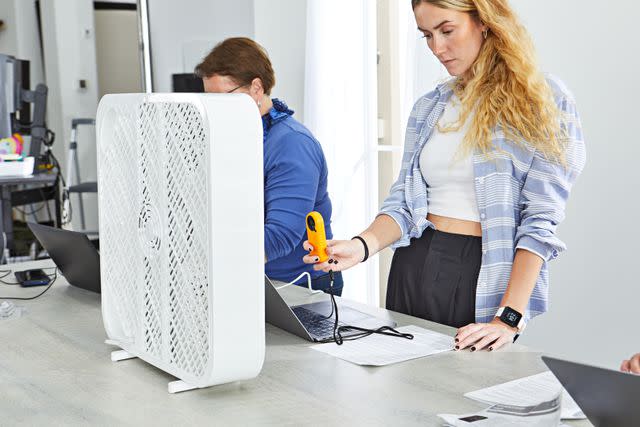
People / Rachel Marek
How We Tested Fans
To find the best fans available today, we gathered 31 popular models in a range of styles and sizes. We set up each fan, then evaluated their performance in the following categories:
Air Speed: We tried out every speed setting on the fan, evaluating the noise level of each and whether there was a noticeable difference in the wind power.
Design: We evaluated the build quality, aesthetics, and features of each fan. We considered things like the materials used, stability, and aesthetic appeal of the design.
Portability: Throughout the course of testing, we noted whether the fan was easy to move around and reposition.
Effectiveness: We put each fan on its highest speed, then stood in front of it at a distance of 6 inches, 6 feet, and 20 feet. We noted whether we could feel the breeze and how well it cooled at these distances.
Overall Value: Based on all the test results, we noted whether the fan’s price felt appropriate for its performance.
After testing, we also sent fans home with product testers, who used them over the course of six months to provide insights on their real-life performance. Using all this data, we scored each fan, and there was a three-way tie for the top spot between the Pelonis Standing Fan, Crane Oscillating Desk Fan , and Better Homes & Gardens 3-Speed Tower Fan. These models all finished with a score of 4.6, so we sorted them into categories based on their best uses.
Frequently Asked Questions
What size cooling fan do I need?
It can be tricky to find the right size fan for your space, as there aren’t clear-cut size guidelines like there are for ceiling fans. Instead, you’ll need to look at a variety of specifications to find the best option for your home. You’ll want to consider factors like blade size (when applicable), CFM (a measure of airflow), number of speed settings, and oscillation angle, all of which play a role in a fan’s performance.
What is a good CFM for a fan?
CFM stands for cubic feet per minute, and it’s a measure of the airflow created by a fan. The CFM of household fans can range significantly, from as little as 100 to several thousand, but in general, 300 to 600 CFM is sufficient for an average-sized room.
However, you’ll want to look at other specs in addition to CFM as you shop: “Relying on singular performance metrics can be misleading if they don’t reflect the full performance of the machine,” warns Jones. “A higher CFM might sound positive, but it may also be reflective of high energy consumption or it might not also correlate to airflow projection, limiting performance in larger spaces.”
What are the two types of cooling fans?
Fans can be sorted into two main categories based on the type of motor they use: direct current (DC) or alternating current (AC). DC fan motors are smaller in size, use less power, offer variable-speed operation, and are generally quieter, while AC fan motors are more affordable and have a longer lifespan. Some fan manufacturers may list what type of motor is inside their products—for instance, the Pelonis Standing Fan has a DC motor—but others may not have this information available.
Why Trust PEOPLE?
Camryn Rabideau is a freelance writer and product reviewer specializing in home, kitchen, and pet products. In her over six years of experience as a product tester, she's reviewed hundreds of items firsthand, and her work appears in publications such as PEOPLE, The Spruce and Homes & Gardens. For this article, she relied on the input of our team of product testers and interviewed Theo Jones, a design engineer in environmental care at Dyson.
What Is People Tested?
We created the PEOPLE Tested seal of approval to help you find the very best products for your life. We use our unique methodology to test products in three labs across the country and with our network of home testers to determine their effectiveness, durability, ease of use, and so much more. Based on the results, we rate and recommend products so you can find the right one for your needs.
But we don’t stop there: We also regularly re-review the categories in which we’ve awarded the PEOPLE Tested seal of approval — because the best product of today might not be the best of tomorrow. And by the way, companies can never buy our recommendation: Their products must earn it, fair and square.
In short, PEOPLE Tested provides recommendations you can trust — every day, every purchase.
Up Next: The 14 Best Pool Cleaners of 2024, Tested and Reviewed
For more People news, make sure to sign up for our newsletter!
Read the original article on People.

